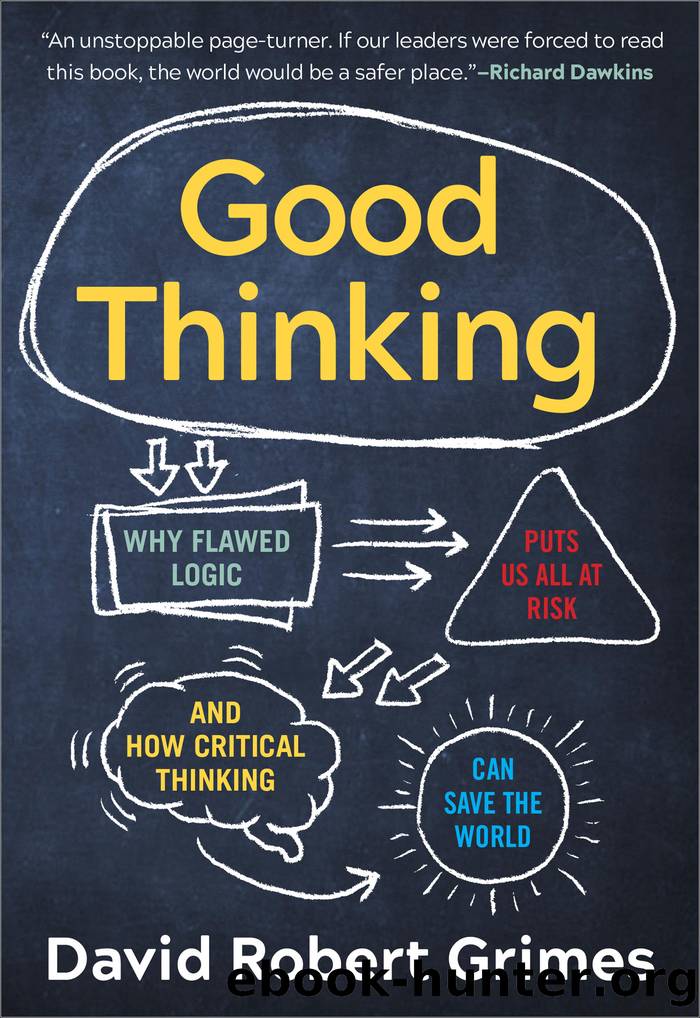Good Thinking by David Robert Grimes

Author:David Robert Grimes
Language: eng
Format: epub
Publisher: The Experiment
Published: 2021-06-15T00:00:00+00:00
Frequency trees depicting reliability of HIV tests for (a) low-risk cohort and (b) high-risk cohort
Returning to our example, how exactly can a test with 99.99 percent accuracy only be half sure a typical patient has HIV? For a typical low-risk subject, baseline infection rate is about 1 in 10,000. Now, imagine 10,000 such people walk in for a HIV test; one of them has the virus and will almost certainly test positive. But in the remaining 9,999, another will test positive due to the accuracy limits of the test, leaving two positive tests, only one of which is a true positive, meaning that with a positive test, a person is 50 percent likely to have the illness.
Crucially, this jarring result does not indicate that the test is inadequate; the HIV test in our example is incredibly accurate. Rather, due to the limited prevalence of the illness, the conditional probability is much lower than what we may intuitively expect. In truth, the a priori likelihood of a particular subject being infected is inextricably entangled with the precision of the result. Consider the same test administered to a high-risk population, such as intravenous drug users. The infection rate in this cohort is roughly 1.5 percent. Letâs again envision 10,000 such patients getting tested. In this cohort, roughly 150 will have the virus and flag positive. Of the remaining 9,850 patients, there should be approximately one false positive. In this instance, the odds of HIV infection given a positive test are not 50/50 any more. The likelihood of a high-risk patient having HIV given a positive test is 150/151 or 99.34 percentâmuch greater than a patient in the low-risk cohort.
The low- and high-risk scenarios can be illustrated more intuitively with a frequency tree, depicted in the figure above. This difference is extreme, and itâs worth dwelling on this finding for a moment. We might reasonably ask: Why the stratification? Why should the same test administered to one group yield an accuracy so drastically different from another group with the same test? Instinctively we may feel there is something wrong with the test, but this is not the caseâthe test does not discriminate, nor does its inherent precision selectively improve or disimprove given a patientâs background. The needle is not clairvoyant, remaining 99.99 percent accurate for all patients. The crux of the issue is that Bayesâs theorem shows us that this information on its own will never be enough to draw conclusions on issues that depend on other probabilities. Probabilities are often conditional, and naked numbers devoid of context need to be carefully parsed.
This serves as an illustration of the fact that, despite the ostensibly intuitive nature of probability and statistics, their seeming simplicity hides layers of complexity that are easy to misunderstand. Such misunderstandings can drive us to entirely erroneous conclusions, and dubious inference and statistical misunderstandings can all too frequently have detrimental consequences. The rationale behind these misunderstandings is no mere academic triviality, nor mathematical sleight of hand; we live in an
Download
This site does not store any files on its server. We only index and link to content provided by other sites. Please contact the content providers to delete copyright contents if any and email us, we'll remove relevant links or contents immediately.
What's Done in Darkness by Kayla Perrin(25485)
Shot Through the Heart: DI Grace Fisher 2 by Isabelle Grey(18206)
Shot Through the Heart by Mercy Celeste(18150)
The Fifty Shades Trilogy & Grey by E L James(17766)
The 3rd Cycle of the Betrayed Series Collection: Extremely Controversial Historical Thrillers (Betrayed Series Boxed set) by McCray Carolyn(13176)
The Subtle Art of Not Giving a F*ck by Mark Manson(12888)
Scorched Earth by Nick Kyme(11820)
Stepbrother Stories 2 - 21 Taboo Story Collection (Brother Sister Stepbrother Stepsister Taboo Pseudo Incest Family Virgin Creampie Pregnant Forced Pregnancy Breeding) by Roxi Harding(11001)
Drei Generationen auf dem Jakobsweg by Stein Pia(10205)
Suna by Ziefle Pia(10174)
Scythe by Neal Shusterman(9246)
International Relations from the Global South; Worlds of Difference; First Edition by Arlene B. Tickner & Karen Smith(8597)
Successful Proposal Strategies for Small Businesses: Using Knowledge Management ot Win Govenment, Private Sector, and International Contracts 3rd Edition by Robert Frey(8403)
This is Going to Hurt by Adam Kay(7671)
Dirty Filthy Fix: A Fixed Trilogy Novella by Laurelin Paige(6444)
He Loves Me...KNOT by RC Boldt(5791)
How to Make Love to a Negro Without Getting Tired by Dany LaFerrière(5364)
Interdimensional Brothel by F4U(5296)
Thankful For Her by Alexa Riley(5146)
